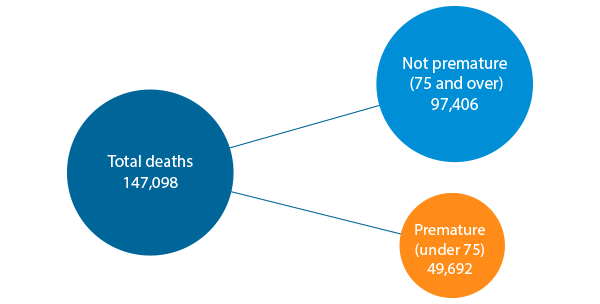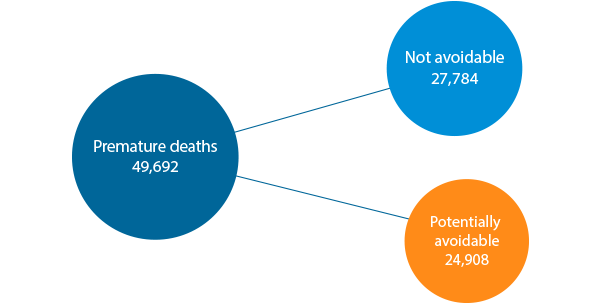Overview of premature mortality
Premature mortality
Premature mortality refers to deaths that occur at a younger age than a selected cut-off. The age below which deaths are considered premature can vary depending on the purpose of the analysis and the population under investigation. Average life expectancy may be used as, or inform, the selected cut-off or an arbitrary age may be set.
For this analysis, deaths among people aged less than 75 are considered premature. This cut-off age produces conservative estimates of premature mortality because it is lower than the current median age at death (81 years in 2012) and life expectancy at birth (80 for males and 84 for females in 2012). This cut-off was chosen to allow for comparisons over time, across population groups and between countries.
Of all deaths in Australia in 2012, over 1 in 3 (34%) occurred among people aged less than 75 (Figure 1.1). That is, there were 49,692 deaths among people aged less than 75 (premature deaths).
Figure 1.1: Premature deaths in Australia, 2012

Source: AIHW National Mortality Database (Table S1, 524KB XLS).
This equates to a rate of 233 premature deaths per 100,000 population aged less than 75 or, put another way, 1 in 429 people aged less than 75 died in 2012. Males accounted for 62% of premature deaths.
Mortality rates in this web report and the accompanying fact sheets represent deaths per 100,000 males/females/persons aged less than 75 (or for each age group reported), unless otherwise stated.
For example, if mortality rates are described for females aged 15–24 as deaths per 100,000 then this refers to deaths per 100,000 females aged 15–24
Potential years of life lost (PYLL)
Premature deaths can be summarised in terms of potential years of life lost (PYLL). For example, if dying before the age of 75 is considered premature then a person dying at age 40 would have lost 35 potential years of life.
Other measures of the impact of premature death are used in measuring the fatal burden of disease, which normally uses the term Years of Life Lost (YLL). These are calculated based on a measure of life expectancy at the age of death rather than a particular age cut-off. The third Australian Burden of Disease Study includes such estimates of YLL using a global standard life expectancy. For more information, see Burden of disease.
Using the age of 75 as the cut-off, there were 848,361 PYLL in Australia in 2012. This is equivalent to the social and economic loss from the lifetime contributions of around 10,000 people living to the age of 85. Expressed another way, in 2012 there were 40 PYLL per 1,000 population aged less than 75.
PYLL rates in this web report and the accompanying fact sheets represent PYLL per 1,000 males/females/persons aged less than 75 (or for each age group reported), unless otherwise stated.
For example, if PYLL rates are described for males aged 65–74 as PYLL per 1,000 then this refers to PYLL per 1,000 males aged 65–74.
Potentially avoidable deaths
Potentially avoidable deaths are deaths among people younger than 75 that are avoidable in the context of the present health care system. They include deaths from conditions that are potentially preventable through individualised care and/or treatable through existing primary or hospital care. They are a subset of the premature deaths reported here.
Potentially avoidable deaths are classified using nationally agreed definitions (AIHW 2015). The data presented here may differ from previous reports as the nationally agreed revisions to the definition of potentially avoidable deaths in 2014 have been applied.
The definition excludes conditions with limited treatment options and/or poor survival rates after diagnosis (e.g. lung cancer). These conditions are not considered potentially avoidable in the context of the present health care system and have been excluded from measures of potentially avoidable deaths. However, premature mortality from these conditions may be reduced through population health interventions targeting risk factors for these conditions (e.g. anti-smoking campaigns) and therefore they are within scope of this report overall (i.e. premature deaths).
Half (50%) of all premature deaths were considered potentially avoidable (Figure 1.2). That is, there were 24,908 potentially avoidable deaths in Australia in 2012.
Figure 1.2: Potentially avoidable deaths in Australia, 2012

Source: AIHW National Mortality Database (Table S1, 524KB XLS).
This equates to 117 potentially avoidable deaths per 100,000 population aged less than 75 or, put another way, 1 in 855 people aged less than 75 died of a potentially avoidable cause.
Reference
AIHW 2015. National Healthcare Agreement: PI 16-Potentially avoidable deaths, 2015. Viewed 9 June 2015.


